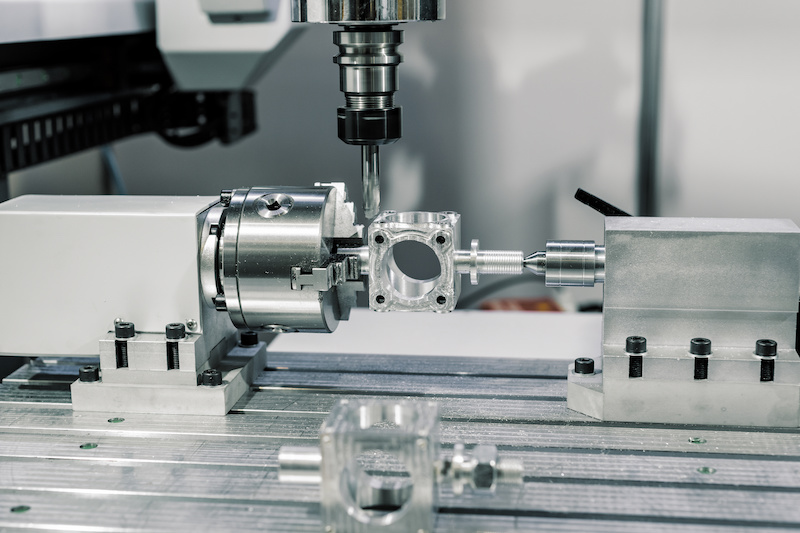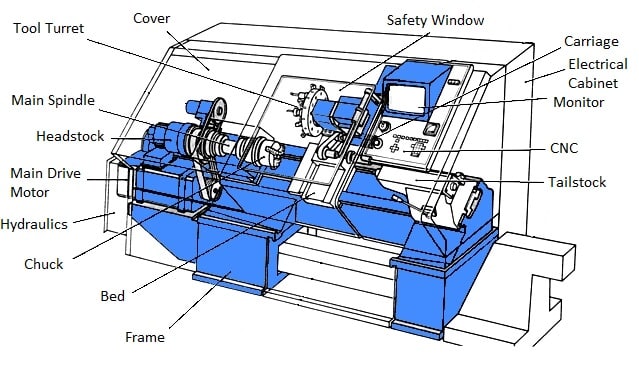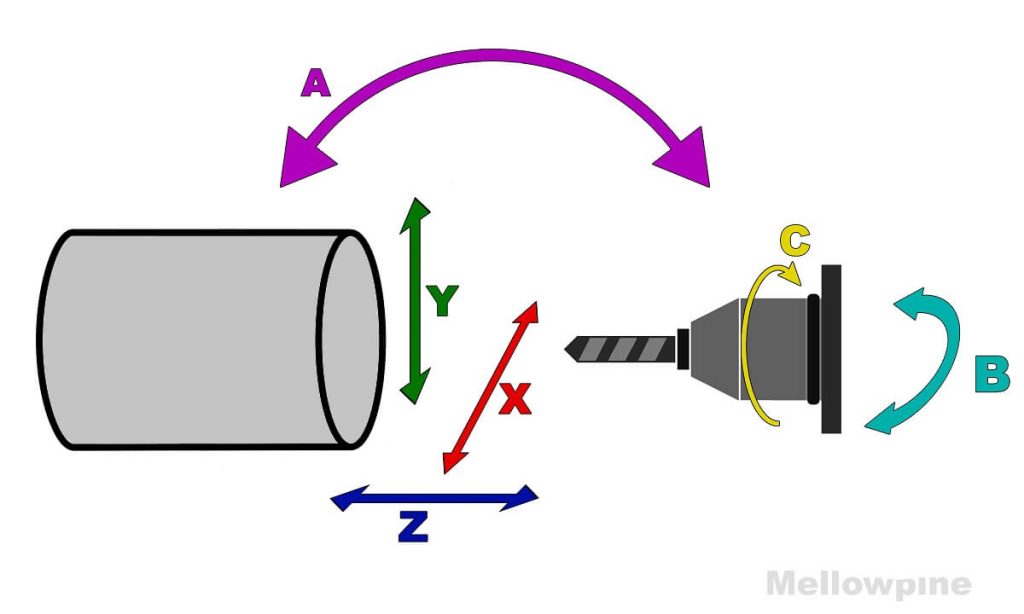Table of Contents
CNC lathe machines are an essential part of the manufacturing industry. These machines use computer-controlled technology to cut and shape materials with incredible precision. But what exactly does a CNC lathe do, and how does it work? In this article, we will explore the basics of CNC lathes, from their history to their modern-day applications. So whether you are a seasoned machinist or simply curious about the world of manufacturing, read on to learn more about one of the most important machines in the industry.
A CNC lathe is a machine tool that rotates a workpiece while a cutting tool moves in various directions to shape and cut the workpiece into the desired size and shape. CNC lathes are used to create precision parts for industries such as aerospace, automotive, and medical. They are also used for high-volume production runs because of their ability to produce consistent and accurate parts quickly.
What Does a CNC Lathe Do?
A CNC lathe is a machine that is used to shape metal or other materials. It is automated and computer-controlled, which means that it is capable of producing precise cuts and shapes with ease. CNC lathes are used in a variety of industries, including manufacturing, automotive, aerospace, and more. In this article, we will take a closer look at what a CNC lathe does and how it works.
How Does a CNC Lathe Work?
A CNC lathe works by using a computer to control the movement of the cutting tool. The material being worked on is held in place by a chuck, which rotates the material. The cutting tool is then moved along the material to remove material and create the desired shape. The computer program that controls the machine is called the CNC program. This program contains all the instructions that the machine needs to create the desired shape.
CNC lathes are capable of producing complex shapes with high precision. They can also be programmed to perform a variety of tasks, such as drilling, tapping, and threading. This makes them ideal for use in manufacturing, where precision and consistency are essential.
Types of CNC Lathes
There are several types of CNC lathes available, each designed for a specific purpose. The most common types include:
- Vertical CNC lathes – These lathes are designed to work on vertical surfaces. They are ideal for turning large, heavy parts.
- Horizontal CNC lathes – These lathes are designed to work on horizontal surfaces. They are ideal for turning long, slender parts.
- Swiss-style CNC lathes – These lathes are designed to work on small, intricate parts. They are capable of high precision and are often used in the medical and electronics industries.
Each type of CNC lathe has its own advantages and disadvantages, depending on the specific application.
Benefits of Using a CNC Lathe
There are several benefits to using a CNC lathe, including:
- High precision – CNC lathes are capable of producing complex shapes with high precision, making them ideal for use in manufacturing.
- Consistency – Because CNC lathes are programmed, they are able to produce consistent results every time.
- Efficiency – CNC lathes are able to work quickly and efficiently, reducing the amount of time it takes to produce a part.
- Versatility – CNC lathes can be programmed to perform a variety of tasks, making them ideal for use in a range of industries.
CNC Lathe vs. Manual Lathe
While manual lathes are still used in some industries, CNC lathes offer several advantages over manual lathes. For example:
- Precision – CNC lathes are capable of producing more precise cuts and shapes than manual lathes.
- Consistency – CNC lathes are able to produce consistent results every time, whereas manual lathes are subject to human error.
- Efficiency – CNC lathes are able to work quickly and efficiently, reducing the amount of time it takes to produce a part.
- Automation – CNC lathes are automated, which means that they require less human intervention than manual lathes.
Conclusion
In conclusion, a CNC lathe is a machine that is used to shape metal or other materials. It is computer-controlled, which means that it is capable of producing precise cuts and shapes with ease. CNC lathes are used in a variety of industries, including manufacturing, automotive, aerospace, and more. They offer several benefits over manual lathes, including higher precision, consistency, efficiency, and automation. If you are looking for a way to produce complex shapes with high precision, a CNC lathe may be the right tool for the job.
Freequently Asked Questions
Here are some frequently asked questions about CNC lathes and their functions:
What is a CNC lathe and how does it work?
A CNC lathe is a machine tool that rotates a workpiece on its axis to perform various operations such as cutting, drilling, knurling, facing, turning, and threading. It uses computer numerical control (CNC) to control the movement and position of the cutting tool. The CNC program provides instructions to the machine on how to move the tool and when to engage the workpiece. The operator inputs the program into the machine and the lathe executes the operations automatically.
CNC lathes have several components such as the spindle, chuck, tool turret, tailstock, and bed. The spindle rotates the workpiece, the chuck holds the workpiece, the tool turret holds the cutting tools, the tailstock supports the workpiece, and the bed provides a stable platform for the components. The cutting tools move in multiple axes to achieve the desired shape and size of the workpiece.
What are the advantages of using a CNC lathe?
Using a CNC lathe has several advantages over traditional lathes. First, it offers greater precision and accuracy in the machining process. The CNC program can control the movement of the cutting tool to within a few thousandths of an inch, ensuring consistent results every time. Second, it increases productivity and efficiency by automating the machining process. The CNC lathe can run continuously without the need for manual intervention, reducing the time and labor required to produce parts. Third, it enables the creation of complex shapes and designs that would be difficult or impossible to achieve with manual lathes.
CNC lathes are also versatile machines that can handle a wide range of materials, from plastics and composites to metals and alloys. They can be used for both small and large production runs and are ideal for creating prototypes and custom parts.
What types of operations can a CNC lathe perform?
A CNC lathe can perform a variety of operations such as turning, facing, drilling, boring, threading, and knurling. Turning is the process of creating cylindrical shapes by removing material from the workpiece. Facing is the process of creating a flat surface at the end of the workpiece. Drilling is the process of creating holes in the workpiece. Boring is the process of enlarging existing holes. Threading is the process of creating threads on the workpiece. Knurling is the process of creating a pattern of small ridges on the surface of the workpiece.
CNC lathes can also perform more complex operations such as contouring, where the cutting tool moves in multiple axes to create intricate shapes and designs. They can also perform parting, where the workpiece is cut off from the rest of the material, and grooving, where a groove is cut into the workpiece.
What are the applications of CNC lathes?
CNC lathes have a wide range of applications in various industries such as aerospace, automotive, medical, electronics, and manufacturing. They are used to produce a variety of parts such as engine components, bearings, shafts, gears, valves, and surgical implants. CNC lathes are also used for prototyping and custom parts manufacturing, where precision and accuracy are critical.
One of the advantages of CNC lathes is their ability to produce high-quality parts with consistent results, making them ideal for mass production. They can also be used for low-volume production runs and custom jobs, where traditional lathes would be less efficient or accurate. CNC lathes are versatile machines that can handle a wide range of materials and geometries, making them a valuable asset for any manufacturing operation.
What are the differences between a CNC lathe and a manual lathe?
The main difference between a CNC lathe and a manual lathe is the level of automation and control. A manual lathe is operated by an operator who controls the movement of the cutting tool by hand. The operator adjusts the speed, feed rate, and depth of cut manually, using their experience and skill to produce the desired result. A CNC lathe, on the other hand, is operated by a computer program that controls the movement of the cutting tool automatically.
CNC lathes offer several advantages over manual lathes such as greater precision, consistency, and efficiency. They are also ideal for producing complex shapes and designs that would be difficult or impossible to achieve with manual lathes. However, they require a higher initial investment and specialized training to operate and maintain. Manual lathes are still used in some applications where precision and accuracy are not critical, and the cost of production is a primary concern.
In conclusion, a CNC lathe is a highly specialized machine used for precision machining tasks. It is a computer-controlled tool that rotates the workpiece on its axis while a cutting tool moves along it to remove material. The CNC lathe can produce complex shapes and parts with high accuracy, making it an essential tool in many industries.
The CNC lathe provides several benefits, such as increased production speed, reduced labor costs, and improved accuracy. It can handle a wide range of materials, including metals, plastics, and wood, making it a versatile tool for various applications.
In summary, a CNC lathe is a sophisticated machine that is essential in modern manufacturing processes. It offers many benefits, such as increased productivity and accuracy, making it a valuable investment for any business that relies on precision machining.
Request a quote today!
[contact-form-7 id="1578" title="Contact form"]
Please compress the file into a ZIP or RAR file before uploading. Alternatively, send through your RFQ by email.
enquires@unitymanufacture.com





